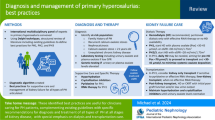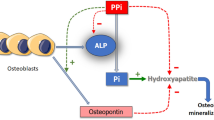Abstract
In the course of the collaborative study of children treated for PKU, urine samples from a total of 165 patients were analysed at six different times: in the newborn period before onset of therapy, after beginning of dietary management, during and immediately after a protein loading test at 6 months of age. In 95.9% of newborns with elevated Phe levels in plasma, metabolites of this amino acid as well as of Tyr could be detected. Of all metabolites phenylpyruvate always showed the highest concentration, followed by phenyllactate and o-hydroxy-phenylacetate. During the protein loading test an increase of the same metabolites occured. At the age of 6 months the percentage of p-hydroxylated compounds related to the sum of all metabolites was lower than in the newborn period. Comparing the results of urine analyses at 6 months of age after the protein loading tests with the classification of HPA into the reaction types I–III, it can be clearly stated that patients with the milder forms II and III have already lower levels of Phe metabolites in urine before onset of therapy compared to the reaction type I. In retrospect 52% of the newborns could therefore be classified as reaction type I even before beginning of dietary management. The analysis of urinary Phe metabolites before the onset of therapy therefore provides sufficient information about the reaction type.
Similar content being viewed by others
References
Behbehani A, Langenbeck U (1983) Age dependance of urinary levels of acidic phenylalanine metabolites in phenylketonuria (PKU). Poster 50, Abstracts SSIEM-Meeting, September 6–9, Lyon
Blaskovics ME, Schaeffler GE, Hack S (1974) Phenylalaninemia. Differential diagnosis. Arch Dis Child 49:835–843
Blau K (1970) Aromatic acid excretion in phenylketonuria. Analysis of the unconjugated aromatic acid derived from phenylalanine. Clin Chim Acta 27:5–18
Blau K, Summer GK, Newsome HC, Edwards CH, Mamer OA (1973) Phenylalanine loading and aromatic acid excretion in normal subjects and heterozygotes for phenylketonuria. Clin Chim Acta 45:197–205
Chalmers RA (1974) A study of the acidic metabolites present in the urine of normal and mentally-subnormal human subjects and of patients with some metabolic diseases, together with some observations on other physiological fluids. Thesis, Council National Academic Awards, London
Chalmers RA, Lawson AM (1982) Organic acids in man. Chapman and Hall, London, p 420
Chalmers RA, Watts RWE (1974) Quantitative study on the urinary excretion of unconjugated aromatic acids in phenylketonuria. Clin Chim Acta 55:281
Hill A, Hoag GN, Zaleski WA (1972) The investigation of aromatic acids in phenylketonuria, alkaptonuria and tyrosinosis using gas-liquid chromatography. Clin Chim Acta 37:455–462
Hoffmann NE, Gooding KM (1969) Gas chromatography of some urinary acid metabolites related to phenylketonuria. Anal Biochem 31:471–479
Jaffe M (1886) Über den Niederschlag, welchen Pikrinsäure in normalem Harn erzeugt und über eine neue Reaktion des Kreatinins. Hoppe Seylers Z physiol Chem 10:391–400
Jagenburg R, Rödjer S (1977) Detection of heterozygotes for phenylketonuria by constant intravenous infusion of L-phenylalanine. Clin Chem 23:1661–1665
Jakobs C, Solem E, Ek J, Halvorsen K, Jellum E (1977) Investigation of the metabolic pattern in maple syrup urine disease by means of glass capillary gas chromatography and mass spectrometry. J Chromatography 143:31–38
Kaufman S (1989) An evaluation of the possible neurotoxicity of metabolites of phenylalanine. J Pediatr 114:895–900
Koepp P, Hoffmann B (1974) Aromatic acid excretion in classical phenylketonuria and hyperphenylalaninaemia variants. Helv Paediatr Acta 29:489–498
Langenbeck U, Behbehani A, Mench-Hoinowski A, Petersen M (1980) Absence of a significant renal threshold for two aromatic acids in phenylketonuric children over two years of age. Eur J Pediatr 134:115–118
Michals K, Lopus M, Gashkoff P, Matalon R (1986) Phenylalanine metabolites in treated phenylketonuric children. J Inherited Metab Dis 9 [Suppl 2]:212–214
Olek K, Oyanagi K, Wardenbach P (1974) Quantitative analysis of phenylalanine metabolites in urine to detect heterozygotes of phenylketonuria. Humangenetik 22:85–88
Rampini S, Völlmin JA, Bosshard HR, Müller M, Curtius H-C (1974) Aromatic acids in urine of healthy infants, persistent hyperphenylalaninemia, and phenylketonuria, before and after phenylalanine load. Pediatr Res 8:704–709
Rey F, Pellie C, Sivy M, Blandin-Savoja F, Rey J, Frezal J (1974) Influence of age on orthohydroxy-phenylacetic acid excretion in phenylketonuria and its genetic variants. Pediatr Res 8:540–545
Schmidt H, Lutz P, Batzler U (1989) Differentialdiagnose des erhöhten Phenylalanin-Blutspiegels im Säuglinsalter. Ergebnisse der deutschen Verbundstudie über Phenylketonurie (PKU)/Hyper-phenylalaninämie (HPA). Monatsschr Kinderheilkd 137: 86–92
Sternowsky HJ, Roboz J, Hutterer F, Gaull G (1973) Determination of alpha-keto acids as silylated oximes in urine and serum by combined gas chromatography-mass spectrometry. Clin Chim Acta 47:371–379
Vavich JM, Howell RR (1971) Rapid identification and quantitation of urinary metabolites of phenylalanine in phenylketonuria by gas chromatography. J Lab Clin Med 77:159–167
Wadman SK, Van der Heiden S, Ketting D, Sprang FJ van (1971) Abnormal tyrosine and phenylalanine metabolism in patients with tyrosyluria and phenylketonuria; gas-liquid chromatographic analysis of urinary metabolites. Clin Chim Acta 34:277–287
Author information
Authors and Affiliations
Rights and permissions
About this article
Cite this article
Mönch, E., Kneer, J., Jakobs, C. et al. Examination of urine metabolites in the newborn period and during protein loading tests at 6 months of age—part 1. Eur J Pediatr 149 (Suppl 1), 17–24 (1990). https://doi.org/10.1007/BF02126294
Issue Date:
DOI: https://doi.org/10.1007/BF02126294




